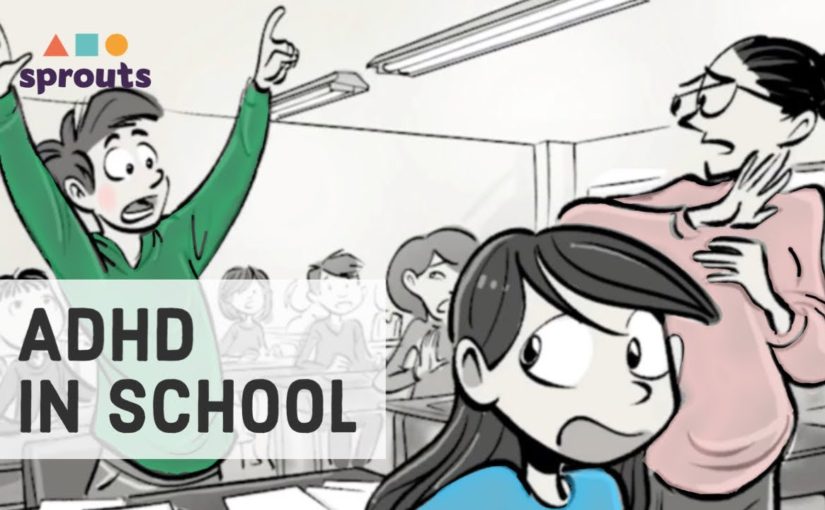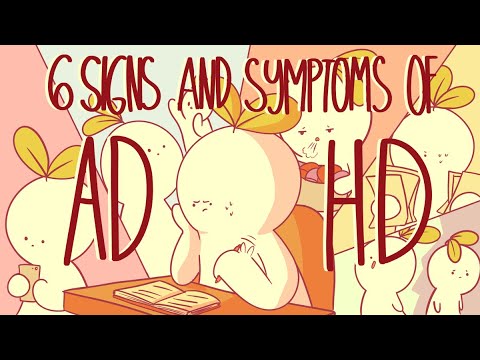– [Amanda] As a quick disclaimer, this video is made for
educational purposes only. And if you have further
questions or concerns about ADHD, please consult with your doctor first. With that said, let’s start. I’m sure you’ve heard of attention deficit hyperactivity
disorder, or ADHD before. It’s a neurodevelopmental disorder marked by an ongoing
pattern of inattention or hyperactivity that interferes with your functioning and development. Though ADHD is most commonly
diagnosed in childhood, it can also affect adults. Unfortunately, there’s a
significant lack of research into adults with ADHD. Many scientists believe that since ADHD is a
developmental disorder, it can not develop in adults
without demonstrating any signs during their early childhood. But, signs and symptoms of ADHD often persist into
adolescence and adulthood. According to the NHS, by age 25, 15% of those diagnosed will
still present symptoms. Of those diagnosed, 65% will have symptoms
that affect their lives. Here are six signs and symptoms of ADHD to look out for it if you
think it’s affecting your life or the life of someone you know. Number one is inattentiveness. One of the hallmark signs
of ADHD is inattentiveness. It goes beyond simply not
being able to pay attention. It can also look like the
inability to focus on a task, finding it hard to pay
attention to others, or overlooking details. Know these symptoms can
also be caused by stress. Pay special attention if you
find your focus shifting often. Number two, hyperfocus. On the opposite side of the spectrum, you can also experience
hyperfocus with ADHD. Hyperfocus can cause a person with ADHD to become so engrossed in a task that they forget about everything
else going on around them. It’s important to differentiate
between hyperfocus versus when you’re in a state of flow. Flow emerges from a state
of deep concentration or engagement in something, and being in flow produces
a positive feeling, like a sense of accomplishment. Hyperfocus, on the other hand, is a result of an inability to
regulate your attention span. With hyperfocus, you can’t
always choose what you focus on. You might be doing something
important like homework or hyper-focused
on scrolling endlessly through Kylie Jenner’s Instagram Feed. Hyperfocus can lead to setbacks in your relationships
with friends or partners, or hurdles at work and school. To help with this, you
could prioritize your tasks and accomplish them one by one, or ask your family and friends
to text you at specific times to help you shift your focus
onto more important tasks. Number three is impulsivity. Do you speak out of turn, or
do you regularly get yourself into socially inappropriate situations? Do you rush through tasks? And these all are signs
of impulsivity in ADHD. It runs a lot deeper than just making split-second decisions. ADHD impulsivity can
disrupt your life, and can potentially get you in trouble.

You might others during conversations, making them less inclined
to talk to you again, or you can act without much or any consideration of
the possible consequences, and this can land you in hot water. Number four is disorganization. We all have hectic lives,
but for someone with ADHD, things may feel a bit
more chaotic than usual. If you have ADHD, you may have trouble
establishing order in your life, and it can be difficult to keep everything in the right place. And adults with ADHD may struggle with these
organizational skills. This can include, problems
keeping track of tasks, and trouble logically prioritizing them. Number five is mood swings. Because this symptom is present
in many other disorders, it’s not an inherent sign of ADHD, but if you’re someone with ADHD you may experience mood
swings or irritability. There may be days you
feel good and grounded, and other days when you’re
in the emotional gutter. You can try writing your emotions down, which can help you keep track
of your emotional patterns, and prepare you for the next mood swing. Setting a schedule will
help you establish a routine and avoid the possible
stress from disorganization. And number six, lack of motivation. Does it seem like you’re
doing everything at once, but feel unmotivated
to go about your tasks? Lack of motivation is a
common symptom of ADHD. A lack of motivation combined
with other symptoms like poor organizational skills is problematic when it
comes to accomplishing tasks or being engaged at work. There are many ways to help fight a lack
of motivation, though. For example, you could
break down your chores into manageable tasks, or write down the positive feelings you’re experiencing throughout the day. These techniques can help
you find the motivation to finish your tasks. Do you think you might have ADHD, or does someone you know
think they could have ADHD? Do you think these signs
will help you or a loved one? Go ahead and like and share
this video if it helped you, and you think it could
help someone else too. The studies and references used are listed in the description below. And don’t forget to hit
the subscribe button for more Psych2Go videos. Thank you for watching, and
we’ll see you next time.
As found on YouTubeHUMAN SYNTHESYS STUDIO 👀🗯 Attention: Have Real Human Spokespeople In Your Videos Saying Exactly What You Want In MINUTES! REAL Humans, REAL Voices, With A NEW Technology That Gives STUNNING Results Choose Your
Human + Voice Type What You Want Them To Say Render your “Humatar” What You Are About To See Is Unbelievable…
 Others become impatient, give up or distance themselves. after he
is diagnosed and receives support through concrete steps, things begin to
get better: at school, he is seated next to a supportive student in the front row
of the class, he gets a notebook that lists all his assignments to help him
remember and to make homework easier to track he receives it for all subjects
only once a week. to relax he is allowed to use fidget objects during lessons and
take short breaks when needed. after school he practices speaking and
listening routines with the specialist. additionally, his dad bikes with him to
school every morning and in the afternoon he is allowed to play the ball
as long as he wishes. for severe cases of ADHD prescription drugs are often
prescribed. before that happens children like Leo need to undergo a
professional age-appropriate diagnosis by a child psychologist who will try to
look below the surface. ADHD could just be the tip of the
iceberg the root cause might be drama at home, bullying at school, poor sleep or
the wrong diet. Sir Ken Robinson told the story of Gillian Lynne, an 8-year-old
girl that was said to have a learning disorder. she could not concentrate and
never sat still. when she was brought to the specialist who didn’t subscribe any
therapy but instead played music on the radio, the girl started dancing. he then
told her mother: “Gillian isn’t sick, she’s a dancer. take her to a dance school!”
Gillian Lynne later became a famous dancer and then responsible for some of
the most successful musicals in Broadway history. please share your thoughts in
the comments below. if you are hyperactive or if you are diagnosed with
ADHD please tell us about your coping mechanisms so we can learn more about it
from reading your insights. if you want to support our Channel, enabling us
to make more such videos, visit patreon.com/sprouts and check out
what we do.As found on YouTubeBrain Booster | Blue Heron Health News ⇝ I was losing my memory, focus – and mind! And then… I got it all back again. Case study: Brian Thompson There’s nothing more terrifying than watching your own brain health fail. You can feel it… but you can’t stop it. Over and over I asked myself, where is this going to end? What am I going to end up like? And nobody could tell me. Doesn’t matter now. I’m over it. Completely well. This is how I did it!
Others become impatient, give up or distance themselves. after he
is diagnosed and receives support through concrete steps, things begin to
get better: at school, he is seated next to a supportive student in the front row
of the class, he gets a notebook that lists all his assignments to help him
remember and to make homework easier to track he receives it for all subjects
only once a week. to relax he is allowed to use fidget objects during lessons and
take short breaks when needed. after school he practices speaking and
listening routines with the specialist. additionally, his dad bikes with him to
school every morning and in the afternoon he is allowed to play the ball
as long as he wishes. for severe cases of ADHD prescription drugs are often
prescribed. before that happens children like Leo need to undergo a
professional age-appropriate diagnosis by a child psychologist who will try to
look below the surface. ADHD could just be the tip of the
iceberg the root cause might be drama at home, bullying at school, poor sleep or
the wrong diet. Sir Ken Robinson told the story of Gillian Lynne, an 8-year-old
girl that was said to have a learning disorder. she could not concentrate and
never sat still. when she was brought to the specialist who didn’t subscribe any
therapy but instead played music on the radio, the girl started dancing. he then
told her mother: “Gillian isn’t sick, she’s a dancer. take her to a dance school!”
Gillian Lynne later became a famous dancer and then responsible for some of
the most successful musicals in Broadway history. please share your thoughts in
the comments below. if you are hyperactive or if you are diagnosed with
ADHD please tell us about your coping mechanisms so we can learn more about it
from reading your insights. if you want to support our Channel, enabling us
to make more such videos, visit patreon.com/sprouts and check out
what we do.As found on YouTubeBrain Booster | Blue Heron Health News ⇝ I was losing my memory, focus – and mind! And then… I got it all back again. Case study: Brian Thompson There’s nothing more terrifying than watching your own brain health fail. You can feel it… but you can’t stop it. Over and over I asked myself, where is this going to end? What am I going to end up like? And nobody could tell me. Doesn’t matter now. I’m over it. Completely well. This is how I did it!


 You might others during conversations, making them less inclined
to talk to you again, or you can act without much or any consideration of
the possible consequences, and this can land you in hot water. Number four is disorganization. We all have hectic lives,
but for someone with ADHD, things may feel a bit
more chaotic than usual. If you have ADHD, you may have trouble
establishing order in your life, and it can be difficult to keep everything in the right place. And adults with ADHD may struggle with these
organizational skills. This can include, problems
keeping track of tasks, and trouble logically prioritizing them. Number five is mood swings. Because this symptom is present
in many other disorders, it’s not an inherent sign of ADHD, but if you’re someone with ADHD you may experience mood
swings or irritability. There may be days you
feel good and grounded, and other days when you’re
in the emotional gutter. You can try writing your emotions down, which can help you keep track
of your emotional patterns, and prepare you for the next mood swing. Setting a schedule will
help you establish a routine and avoid the possible
stress from disorganization. And number six, lack of motivation. Does it seem like you’re
doing everything at once, but feel unmotivated
to go about your tasks? Lack of motivation is a
common symptom of ADHD. A lack of motivation combined
with other symptoms like poor organizational skills is problematic when it
comes to accomplishing tasks or being engaged at work. There are many ways to help fight a lack
of motivation, though. For example, you could
break down your chores into manageable tasks, or write down the positive feelings you’re experiencing throughout the day. These techniques can help
you find the motivation to finish your tasks. Do you think you might have ADHD, or does someone you know
think they could have ADHD? Do you think these signs
will help you or a loved one? Go ahead and like and share
this video if it helped you, and you think it could
help someone else too. The studies and references used are listed in the description below. And don’t forget to hit
the subscribe button for more Psych2Go videos. Thank you for watching, and
we’ll see you next time.
You might others during conversations, making them less inclined
to talk to you again, or you can act without much or any consideration of
the possible consequences, and this can land you in hot water. Number four is disorganization. We all have hectic lives,
but for someone with ADHD, things may feel a bit
more chaotic than usual. If you have ADHD, you may have trouble
establishing order in your life, and it can be difficult to keep everything in the right place. And adults with ADHD may struggle with these
organizational skills. This can include, problems
keeping track of tasks, and trouble logically prioritizing them. Number five is mood swings. Because this symptom is present
in many other disorders, it’s not an inherent sign of ADHD, but if you’re someone with ADHD you may experience mood
swings or irritability. There may be days you
feel good and grounded, and other days when you’re
in the emotional gutter. You can try writing your emotions down, which can help you keep track
of your emotional patterns, and prepare you for the next mood swing. Setting a schedule will
help you establish a routine and avoid the possible
stress from disorganization. And number six, lack of motivation. Does it seem like you’re
doing everything at once, but feel unmotivated
to go about your tasks? Lack of motivation is a
common symptom of ADHD. A lack of motivation combined
with other symptoms like poor organizational skills is problematic when it
comes to accomplishing tasks or being engaged at work. There are many ways to help fight a lack
of motivation, though. For example, you could
break down your chores into manageable tasks, or write down the positive feelings you’re experiencing throughout the day. These techniques can help
you find the motivation to finish your tasks. Do you think you might have ADHD, or does someone you know
think they could have ADHD? Do you think these signs
will help you or a loved one? Go ahead and like and share
this video if it helped you, and you think it could
help someone else too. The studies and references used are listed in the description below. And don’t forget to hit
the subscribe button for more Psych2Go videos. Thank you for watching, and
we’ll see you next time.